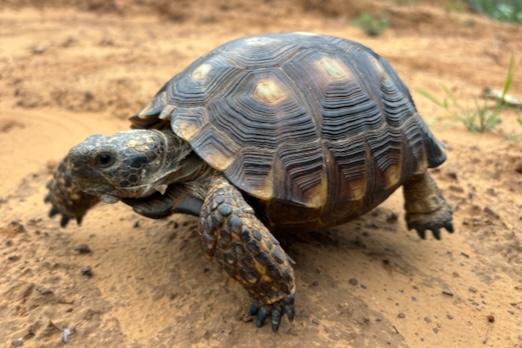
A Texas Tortoise at the study site. Photo by Viviana Ricardez.
The story of turtles is an old tale.
Their earliest ancestors pre-date the dinosaurs, and by the first great Age of Reptiles, in the Triassic, there were turtles with shells. They stuck with that plan for about 200 million years. So it is ironic that in our time there is a risk that the turtle lineage might die out.
Texas has no shortage of turtles from the small and cute “Stinkpot” to the massive Alligator Snapping Turtles. Some seem to be doing okay while others are declining or in serious trouble. A group of turtle researchers in Texas has been studying species such as the alligator snapper. The three biologists and some associates comprise the nonprofit Texas Turtles. They spend many hours in the field but are also devoted to educating us about these amazing animals
TEXAS TURTLES
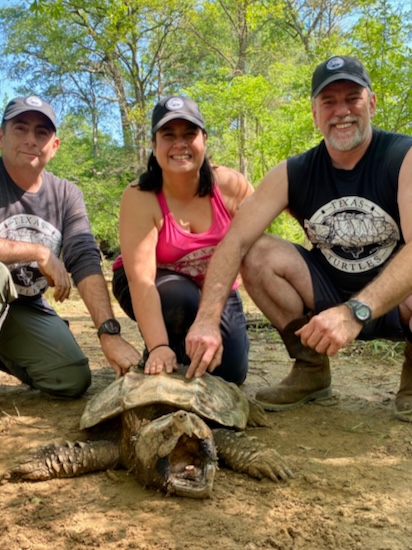
The organization got its start when Carl Franklin, a former biological curator collections manager and herpetologist at the University of Texas at Arlington, set up an educational website called “Texas Turtles” years ago.
The site continues to feature information and photographs for each family of turtles and most of their species in our state. A typical entry for a species describes ID tips as well as some notes about its behavior and ecology. The range in which the species naturally occurs is shown on a county-by-county map of Texas. And then there are multiple photos of the species, because males and females may look different, juveniles look different, and every individual varies some in color and pattern.
But there was more work to be done to fill what Grand Prairie-based Franklin calls a “Texas-sized hole in our knowledge of Texas’ turtles.”
In 2019, Texas Turtles was formed as a 501.c.3 organization in Texas by Franklin (now president). He was joined by vice president Viviana Ricardez and for a brief time by me. The organization is “devoted to the conservation and study of Texas turtles through research, the study of turtles in the wild and outreach education,” according to the website. Sal Scibetta came aboard later as secretary, the third principal officer.
Most of their funding comes directly from the people of Texas. Franklin told me that “82 percent of our funding comes directly from social media donations and T-shirt sales” (See their merch and donation page).
The officers and associates are all volunteers. He said that an advantage of having that kind of structure was that there’s no administrative costs so that donations go directly to support the equipment, materials and travel required in their work. All three officers hold jobs outside of Texas Turtles.
TURTLES ARE IN TROUBLE
Declines in turtles makes it more urgent that we understand these reptiles. To conserve them, we need to know more about how they are doing in the wild and how they contribute to the places where they live.
“Turtles are struggling to persist in the modern world,” turtle biologist Jeffrey Lovich and others said in a 2018 article on Researchgate.net.
As many as 61 percent of species worldwide are being threatened or having become extinct. The troubles they face generally include habitat destruction, removal from the wild for the commercial pet trade or for food, as well as climate change and disease, according to the authors.
In Texas, nine turtle species are listed as threatened or endangered (including the five species of sea turtles seen along the coast).
ALLIGATOR SNAPPING TURTLES
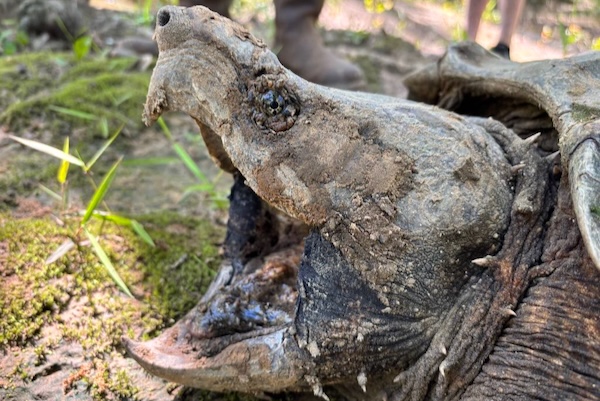
Texas Turtles is researching several threatened and endangered species, with the Alligator Snapping Turtle at the head of the list.
“Alligator Snapping Turtles are the biggest freshwater turtles in the Western Hemisphere, and they are ecological movers and shakers. They live to eat, and they eat to live,” Franklin told me.
He described them as apex omnivores, meaning that they sit at the top of the food chain, eating animal and plant matter.
Males grow bigger than females, and the largest known male caught in Texas weighed 211 pounds. Many people know them by their big knobby shells with three front-to-back ridges, big heads with hooked jaws, and the little wiggling tongue appendage that works like a lure to invite prey into their cavernous mouths. Alligator Snapping Turtles live within some East Texas rivers, sloughs and other wetlands, spending most of their time underwater. They are protected in Texas and were once considered rare, but according to Franklin the evidence indicates that they are elusive rather than rare.
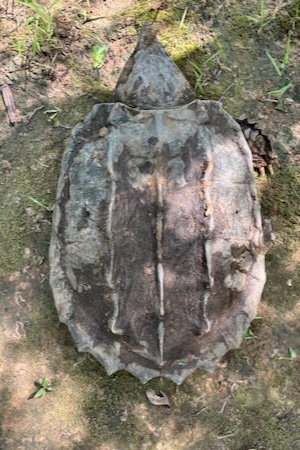
“Texas may have as many as 600,000 Alligator Snapping Turtles,” though that number might be closer to 250,000 based on researchers, including Texas Turtles and several universities.
There is good reason to continue protecting them, because without protection they might be over-harvested. Turtles generally, and these snappers in particular, depend on living to an old age so that the population can keep going.
“These are animals that are much like us — they are slow to mature and long-lived,” Franklin said.
Their reproductive output is not very high, and most eggs and juveniles do not survive.
In the past there has been considerable poaching by Louisiana residents coming to Texas. Because in their state, where hunting them remains legal, they could not find turtles as big as the ones in Texas. When there are only a few old, big ones, that’s a sign that they are being over-harvested. These turtles are also killed as by-catch when people fish with such things as trotlines.
When this happens, the hook should be removed and the turtle released.
TURTLES IN THE MEDIA
Texas Turtles’ conservation efforts has included collaboration with wildlife educator and media figure Coyote Peterson. Working with Peterson highlights their commitment to educational outreach with the public, as most people are more likely to watch a Coyote Peterson video than to read a scientific paper.
Alligator Snapping Turtles will also play a part in a second Deep in the Heart film. The first was a documentary of Texas wildlife, and the follow-up film in the works, subtitled “A Texas River Story,” will highlight Texas rivers. Franklin told me that Texas Turtles spent seven or eight days in the field with the crew.
“It was tremendous to be a part of the first time that Alligator Snapping Turtles got that media attention from Texas,” he said.
SNAPPERPALOOZA
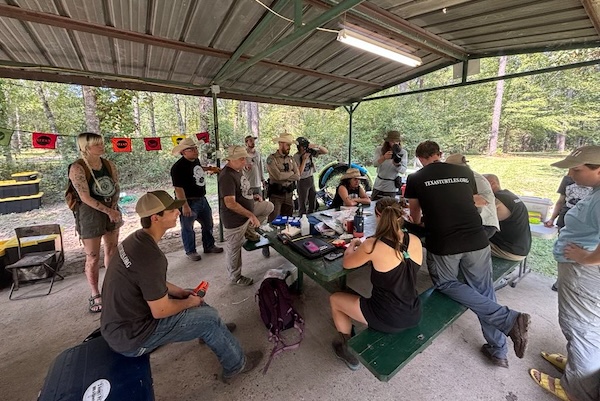
The nonprofit found another way to combine education with science, at a site near the Big Thicket. Ricardez described it as a “happy accident.” They went to look at a place near where a property owner found one run over on the road. Looking at this person’s property, a light bulb went off.
“Carl and I immediately said, ‘We could have an event here. Like we could have [volunteers] come out — it could be a bi-annual event. It could be a Snapperpalooza!’”
And the name stuck. That first weekend they found, measured and released eight alligator snappers.
OTHER TURTLE SPECIES
Texas Turtles has another site where they hope to study the Western Chicken Turtle, a species that most biologists are concerned about. They have a specimen that was surrendered from a pet store that didn’t know what they had, and by using scent from that turtle they could train a dog to locate them without harming them.
They are also interested in box turtles, a group that Franklin says are challenging to find.
“We have plenty of evidence of their decline.”
They have suffered primarily from habitat loss, being run over on highways and people collecting them. At a study site in South Texas, they are studying Ornate Box Turtles along with the Texas Tortoise.
The United States has three turtles that deserve the name “tortoise,” based on those elephant-looking hind legs with species in the Southeastern U.S., South Texas, and the deserts of the Southwestern U.S. Texas Turtles is studying the Texas Tortoise in a partnership with the landowner at a ranch in South Texas.
“I think we’ve got the biggest density of Texas Tortoises ever studied,” Franklin said. “We’ve done 10 field days, and we already have over 50 individual tortoises.”
Their permitted research will allow them to study size ranges, sex ratios, microhabitats used by the tortoises and tissues that provide genetic information (without harming the animal).
“One of the things we are permitted to do is to take genetic tissue samples from turtles all over Texas (except sea turtles), and we created a genomic bank … establishing a scientific research collection endorsed by organizations such that it meets the same criteria that the Smithsonian has to meet,” Franklin said
TWO YOUNG RESEARCHERS
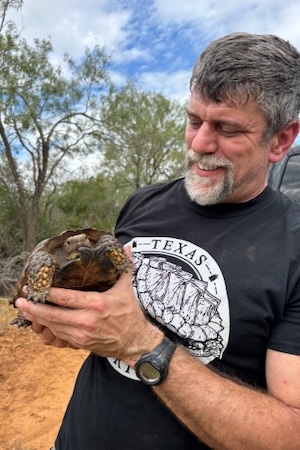
I wanted to know how this passion by the Texas Turtles duo began.
“I got started with the appreciation of nature the first time I went outside,” Franklin said. “As a small child, it was anything – insects, spiders, snails, worms, plants.”
And, of course, turtles.
“It was 1974 or 75, riding around in the car with my parents, and my dad stopping to move box turtles out of the road. Every now and then, I’d get to hold on to that turtle for an hour or so. I always wanted to keep it.”
Franklin added, “I didn’t have a single video game growing up. I was outside all the time.”
Regarding how the love of anything in nature might get started, he said,
“I think that it could be traced back to a point in childhood when you experienced unfettered, unadulterated joy” when experiencing a particular animal. “The discovery and learning … it’s such a powerful thing.”
Franklin described his interest and his work as “a selfish obsession.” When I questioned the word “selfish,” he commented, “I think that is OK. Not everything that produces a good outcome has to be done out of altruism.”
When you take deep personal satisfaction in what you do, that can produce better results even more quickly, in his view.
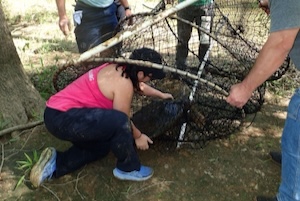
I asked Ricardez how her deep fascination with turtles began.
“It all started with my dad finding a slider crossing the road [here in Arlington],” she said.”I was more interested in questions about the actual animal rather than ‘oh how cute.’ I was seven or eight at the time.”
In 1996, at age eleven, she was journaling about turtles she had seen, recording their names and her observations.
“Finding my journal was really eye-opening.”
For a while she kept captive reptiles, but seeing them in the wild was more thrilling.
“Out in the field, getting to sit and watch them swim, or seeing a turtle head pop up in the river. There’s nothing that matches that — keeping them in captivity cannot match that.”
Her love of turtles was established early and continued to be a dominant interest through her teens. As a result, she felt different and lonely in her junior high and high school years. Ricardez was following a different path at a time when there was peer pressure to be like everyone else. Then in 2016 she met Carl Franklin and saw “there’s somebody else like me.”
PURPOSE
When I asked about the purpose of their organization, Ricardez said it satisfies a deep desire to understand these animals and to spend time with them out in natural places in Texas. She also talked about the turtles and what they have been able to learn about them.
Because of their work, more people know which turtle species are threatened and why they’re in need of protection. Their studies also shed more light on how they live, and that knowledge tells us the kinds of actions needed to conserve them. Is their habitat disappearing, or are people taking too many out of the wild? Or maybe something else is causing their disappearance.
Only after we know the answers can we help.
“There’s the conservation element, the findings and discoveries and the natural history and ecology stuff,” Ricardez said. “And also there’s creating the connection with the community and with people.”
Especially meeting other people who care about turtles.
